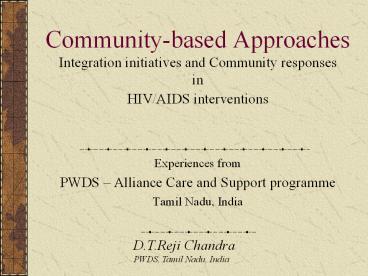Community-based Approaches Integration initiatives and - PowerPoint PPT Presentation
1 / 25
Title:
Community-based Approaches Integration initiatives and
Description:
Community-based Approaches Integration initiatives and Community responses in HIV/AIDS interventions Experiences from PWDS Alliance Care and Support programme – PowerPoint PPT presentation
Number of Views:211
Avg rating:3.0/5.0
Title: Community-based Approaches Integration initiatives and
1
Community-based ApproachesIntegration
initiatives and Community responsesinHIV/AIDS
interventions
- Experiences from
- PWDS Alliance Care and Support programme
- Tamil Nadu, India
D.T.Reji Chandra PWDS, Tamil Nadu, India
2
Palmyrah Workers Development Society PWDS
a development support organization founded in
1977.
Support services to sustain community initiatives
3
- PWDS works for
community self-management and
sustainability and - believes in MEALS approach
- Motivating
- Equipping
- Accompanying
- Linking
- Sustaining
4
PWDS works in the following sectors
- Agriculture
- Enterprise and marketing
- Micro finance
- Shelter technology
- Child care and education
- Community health
- HIV/AIDS
5
HIV/AIDS Intervention
Community health-1984 HIV/AIDS Prevention
-1996 Care and Support - 2000
6
- PWDS-AllianceCommunity-based Care and Support
Programme - in
- Tamil Nadu, India
PWDS
INGOs CBOs
EU
7
Tamil Nadu Districts 13 NGOs 20
Central and South TamilNadu Rural areas -
Selected villages Economically weaker
sections Community-based NGOs
8
Problems faced by children affected by HIV/AIDS
- Expelled from school due to stigma.
- Forced to leave school due to financial
difficulties. - Forced to discontinue because parents migrate.
- Stigmatized discriminated- abused at all
levels. - Branded as cursed especially the orphans.
- Faced with starvation.
9
- Lack emotional support.
- Working children and child-headed families.
- Children as care givers.
- Street children/sexually abused and forced
into - commercial sex.
- Denial of property rights and property
grabbing. - Unfulfilled emotional, health, educational,
- nutritional, and social needs leading to
insecurity - and increased vulnerability.
10
Community mobilization process
- Self-help groups CBOs, Youth Clubs
- Community-based NGO facilitation
- Integrated approach with CD programs
- Linkage with mainstream health care providers
- Networks and collective functioning
- Volunteers, religious leaders
11
Identification strategies
- Sensitization through direct participation.
- Diverse identification strategies based on the
- context and ongoing development initiatives.
- Identification/access as part of the community
- development process.
- Mutual learning by sharing field experiences.
12
The Reach 2001 - 03 13 districts, 580 villages,
through 20 partners
Number of affected people reached 6944 Number
of children 2109 Volunteers 399 Organized
training 27 with 824 participants Community
leaders trained 24,941 Community Self-help
groups 337 Hospitals/doctors linked Private and
government187 Care centers 3 Average annual
budget per NGO .15,000 Lead partner (PWDS)
coordination expense 8.74
13
Stigma and Discrimination
Stigma and discrimination does exist at all
levels, sectors, and services. Negative
attitudes and responses are common experiences in
the initial stages. But there are also
encouraging positive experiences as a result of
the mobilization and sensitization process.
14
Community responses
- Home-based care
- Donation for food, education, clothes
- Educational support
- Adoption/sponsorship by relatives
- SHG sponsorship - integration
- Housing support
- Access to care institutions/meal centers
- Medicines and health care
- Volunteers
15
Community support available for educational,
nutritional, shelter, health, and emotional needs
of the children. Encouraging response
from Primary health centers, government
hospitals, and private medical practitioners as
a result of linkages. Volunteers from among
the affected people and others.
16
A fistful of rice Community responds by
contributing rice.
The story of a seven-year-old child A specific
struggle for readmission in school which
generated sustained impact. Education for this
child was the starting point that led to many
other initiatives for children affected by
HIV/AIDS.
17
There is no fear of HIV/AIDS when I see her
children I only feel for them.
- SHG member
I have two children. If she dies, I will take
care of her three children and bring up all of
them as my own -a relative of the infected
woman in the SHG.
18
Community-based interventions
- Building on what exists
- Need-based interventions
- Participatory tools and methods
- Collective functioning
- Integrated approach
- Process planning
- Rapid appraisals
- Strengthening existing capacities
- Linkages and Mainstreaming
19
Community-based interventions
- Establishing working models for replication and
- mainstreaming
- Sustainability through community
participation, - viable operation and mainstream linkages
- Space in the project framework for initiating a
- sustainability process
20
Constraints Challenges
- Rural poverty, illiteracy, cultural issues
- Fatalistic attitude
- Lack of resources, capacity, services
- NGO capacity and reach
- Policy limitations
- Project framework limitations
- Stigma HIV, orphans, poverty
21
Constraints Challenges
- Community Service providers or clients
- Alternative services or mainstreaming
- Networks/SHGs - potentials and limitations
- Sector specialization and isolated
interventions - (ASOs, Development NGOs, and CBOs)
- Issues in prioritizing HIV children/families in
- the context of marginalized children/poverty
22
Lessons and a way forward
Importance of poverty related issues in planning
community-based HIV/AIDS interventions.
Poverty, girl child, rural context, and
HIV/AIDS is a complex combination that demands
interventions with a broader development
perspective.
23
- Instead of focusing on negative experiences
- building on the positive responses of the
- community is the way forward.
- Empowering community to face the challenge,
- along with centralised delivery of services,
- is important for effective results.
24
Participatory process is the key in
community-based approach. Reliable and
competent partnership is essential for effective
community-based interventions. Confidence in
partners reliability, implementing ability, and
process managing capacity are more important than
monitoring of strict adherence to the
planned project frame and activities.
25
Palmyrah Workers Development Society Paving
Ways for Development Services

